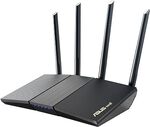Looks like a good price for this router. Asus web site says that it is still supported and is a recommended replacement for the EOL'd models.
- WiFi 6(802.11ax) standard supporting MU-MIMO and OFDMA technology for better efficiency and throughput.
- RT-AX1800S supports 1024-QAM for dramatically faster wireless connections. With a total networking speed of about 1800Mbps — 574 Mbps on the 2.4GHz band and 1201 Mbps on the 5GHz band.
- Supporting not only MU-MIMO but also OFDMA technique to efficiently allocate channels, communicate with multiple devices simultaneously
- Aiprotection powered by Trend Micro, blocks internet security threats for all your connected smart devices.
- Compatible with ASUS AiMesh WiFi system for seamless whole-home coverage.




 CamelCamelCamel
CamelCamelCamel
Would any of you router experts recommend this for a 2-bed apartment?